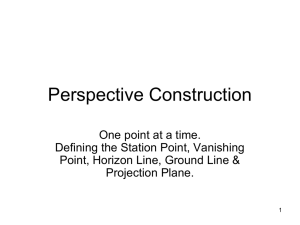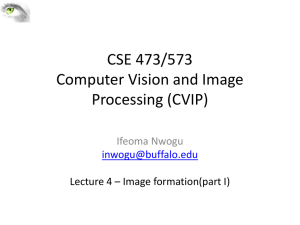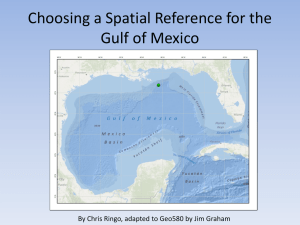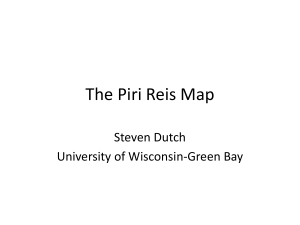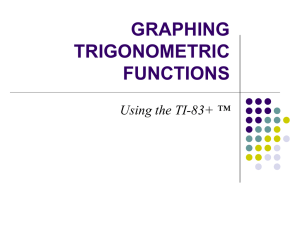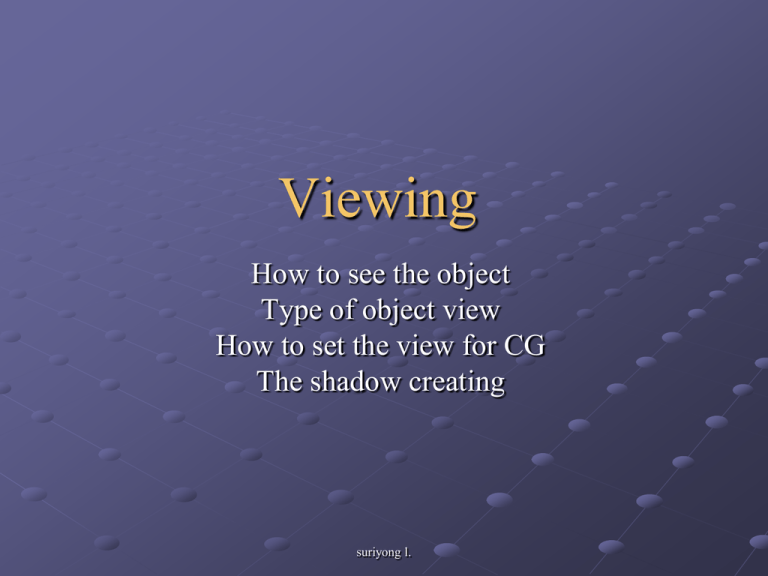
Viewing
How to see the object
Type of object view
How to set the view for CG
The shadow creating
suriyong l.
Type of Views
Examine how an app viewer can create a particular
view within OpenGL
Use model-view matrix to switch from world frame to
camera frame: camera at origin
Preferred projection type :
parallel, perspective
suriyong l.
Principle of view
Classical view and computer view are Similar
COP at infinity
Viewing
COP: Center Of Projection ex. eye , camera lens, for CG: the camera frame
DOP: Direct OP - view at infinite distance
suriyong l.
COP condition
Finite distance view
perspective view
Infinite distance view
Parallel view
Limiting case of perspective view
Treat as separate case
API support both view
User easily switch between view
Use planar geometric projection viewing method:
Object project on planar surface (plane and projection lines)
2 types of view for CG but classical permit more than one
viewer one-, two- etc.
suriyong l.
Classical view
Underlying notion of principal face
Object is composed of a number of planar faces front, back,
top, bottom, etc.
Classical views
suriyong l.
Orthographic projections
An Orthogonal view
Projectors are perpendicular to projection plane
Multiview Orthographic projection
Projection plane is parallel to one of the principle faces,
usually 3 faces
Orthographic projection
suriyong l.
Temple and three multiview
orthographic projections
Orthographic properties
Preserve both distances and angles:
No distortion in shape
Projectors perpendicular to plane
Projection plane is parallel to one principal of
object face
Applied in drawings
suriyong l.
Axonometric projection
Plane rotational orthogonal projection
Plane is not perpendicular to 1 face
Special case
Isometric :
plane is places symmetrically with 3 simple faces
Dimetric:
plane is places symmetrically with 2 simple faces
Trimetric
No faces are places symmetrically with plane
suriyong l.
Axonometric projections. (a) Construction of trimetric-view projection. (b) Top view. (c) Side view.
Axonometric views
suriyong l.
Types of orthographic view
Oblique view (planar face view)
Axonometric view
suriyong l.
Oblique View
Projector make an arbitrary to projecting plane
Able to see more than 1 face at the same time
Most difficult to draw by hand
Lens parallel to plane
Unnatural
Oblique view (a) Construction. (b) Top view. (c) Side view.
suriyong l.
Perspective View
Diminution of size
Unable to measure
Real-looking image
For classical perspective 1-, 2- or 3- point perspective
Perspective view
Classical perspective views: The (a) three-, (b) two-, and
(c)suriyong
one-point
l. perspectives
Viewing with a computer
OpenGL View
Perspective camera – 1 point of view
Orthogonal camera
Initial camera position.
Imaging using the default camera.
suriyong l.
Positioning of the camera
Convert reference of model frame to camera frame
First at point P (both frame at vertex)
Last at point Q
Camera frame C
Initial camera position.
Movement of the camera and world frames. (a) Initial
suriyong (b)
l. Configuration after change in the model view
configuration.
matrix
Suppose to see object at +x direction
glMatrixMode(GL_MODELVIEW); //Initialize matrix_mode to Model_view
glLoadIdentity();
glTranslatef(0, 0, -d);
// Translate far from origin with distance d
glRotatef(90.0, 0.0, 1.0, 0.0); // move camera to x axis (rotate around +y)
suriyong l.
Create Isometric view
Object moving
Transform object to isometric view type
Camera moving
Move the camera to the isometric view type
suriyong l.
Object moving
// Assume that we have 2 unit cube
glMatrixMode(GL_MODELVIEW);
glLoadIdentity();
glTranslatef(0.0, 0.0, -d);
// move camera backward
glRotatef(35.26, 1.0, 0.0, 0.0); // Rotate around x axis (35.26o)
// Point (-1, 1, 1) move to (0,0, √2)
glRotatef(45.0, 0.0, 1.0, 0.0); // Rotate around y axis (45o)
glOrtho(…);
// view clipping
The (-1, 1, 1) is rotate to
the new point (0, 0, √2)
and translate to -d
positive z-axis view
x-axis view
suriyong l.
Create an Isometric view
Symmetrically rotate object to see 3 faces together
Rotate about the y-axis (45o) and x-axis (-35.26o)
consequently
Move away from WCS with distance d
M = Ry(45) .Rx(-35.26). T(-dz)
suriyong l.
Camera moving
Two Viewing APIs (Normalization transformation process)
Start at world frame, camera at origin look to –z direction, define the projection point on
projection plane as VRP (View Reference Point)
Specify VRP – View Reference Point with user’s function
set_view_reference_point(x, y, z);
Specify camera orientation: fix the camera orientation - user’s
function
VPN (View Plane Normal vector - n)
set_view_plane_normal(nx, ny, nz);
VUP (View UP vector) : up direction
set_view_up(vup_x, vup_y, vup_z);
suriyong l.
Camera
frame.
Specify v from VUP Projection
Create u from v, n cross product
u=vxn
Get new orthogonal coordinate system u-v-n called viewing-coordinate system
matrix that does change frame called view-orientation matrix
Let p is VRP
x
y
p
z
1
View plane normal (n)
nx
n
n y
nz
0
VUP
vupx
vup y
vup
vupz
0
Target:
Fine the isometric matrix which composed of translation and
rotation
V = RT
// V: the isometric matrix
Move the camera to the VRP by translation matrix let
T (-x, -y, -z)
suriyong l.
Determination of
the view-up
vector.
Handling rotation
To finding v let
v = n vup
set 1 then (don't care the length of vup factor at first)
v n vup
and
n.vup
; n.v = 0
n.n
v is the proportion of vup and
v vup
vup .n
n
n.n
From v and n we can find u from u = v× n
let u', v' and n' are normalized of u, v and n
we can create rotation matrix M
u x
u
y
M
u z
0
vx
nx
vy
ny
vz
nz
0
0
0
0
0
1
suriyong l.
We need matrix in the form of inverse thus,
R = M-1 = MT ; R is the rotation matrix
Finally, multiply by T then
u x
v
V = RT x
nx
0
u y
vy
ny
u z
vz
nz
0
0
xu x yu y zu z
xvx yvy zvz
xnx yny znz
1
Note:
Translation matrix is on the right, first on the left second
derivation, camera was specified in the world frame both have
similar forms
suriyong l.
The Look-At function
Isometric viewing function
Use model of VRP, VPN and VUP
gluLookat(eyex, eyey, eyez, atx, aty, atz, upx, upy, upz);
eyex, eyey, eyez : location of VRP
atx,aty, atz : target object (VPN = [atx-eyex, aty – eyey])
upx, upy, upz : (VUP = [upx-eyex, upy-eyey])
Look-at positioning.
suriyong l.
OpenGL application sequence
glMatrixMode(GL_MODELVIEW);
glLoadIdentity();
gluLookAt(eyex, eyey, eyez, atx, aty, atz, upx, upy, upz);
// define objects here
suriyong l.
Other Viewing APIs
Roll, pitch and yaw
Elevation and azimuth
suriyong l.
Perspective Projection
Condition:
COP at the origin
Camera point to –ve Z axis
We will consider the first case
in detail
Two possibility of camera for perspective projection
(a) view plane parallel to lens and normal to z axis
(b) view plane not parallel, but lens orthogonal to z axis
suriyong l.
Calculation step
1.
Let point in space is located at x, y, z
2.
Projection plane is perpendicular to –z axis and located at z = d
3.
Project that point to projection plane, let’s say xp, yp, zp
x
z/d
y
yp
z/d
zp d
xp
Summary
Three views of perspective projection. (a) Three-dimensional view. (b) Top view.
(c) Side view.
1.
Non uniform shortening
2.
The closer of object, the size is much more reduce
suriyong l.
Using homogeneous coordinate
wx
wy
p
wz
w
we need w 1
x
y
p z
1
Perspective projection transformation
q Mp
1
0
0
0
0 0
1 0
0 1
0 1/ d
0 x
0 y
0 z
0 1
yp
Divided by 4th component
Then
xp x
z/d
y
z/d
zp z d
z/d
x
z/d x p
y yp
q z/d
zp
d
1
1
Projection pipeline.
suriyong l.
= q
Orthogonal Projection
Special case of perspective projection
Projectors are perpendicular to view plane
Rather than cop at infinity, let z = 0 then
Transformation matrix form
Orthogonal projection
x p 1 0
y p 0 1
0 0
zp
1 0 0
suriyong l.
0
0
0
0
0 x
0 y
0 z
1 1
xp x
yp y
zp 0
Projection in OpenGL
More property for camera: angle of view
Only objects that fit in within angle of view
of the camera appear in the image
Definition of a view volume
Front and back clipping planes
suriyong l.
Perspective in OpenGL
2 function for specifying perspective view
glFrustum(xmin, xmax, ymin, ymax, near, far);
Note: near, far are +ve, measured from COP (at z = 0)
glFrustum(left, right, bottom, top, near, far);
Specification of a frustum
suriyong l.
We must select the matrix mode
glMatrixMode(GL_PROJECTION);
glLoadIdentity();
glFrustum(xmin, xmax, ymin, ymax, near, far);
Note: no need for xmin, xmax or ymin, ymax are symmetry to z axis
Many application specify the angle of view
projection plane need not to be square
suriyong l.
gluPerspective(fovy, aspect, near, far); // For specifying angle of view
fovy: angle between the top and bottom
aspect: the ratio of w divided by h of projection plane
near, far : plane specified as glFrustum
Specification using the field of view.
suriyong l.
Parallel view in OpenGL
Use function glOrtho
glOrtho(xmin, xmax, ymin, ymax near, far)
Or
glOrtho(left, right, buttom, top, near, far)
Orthographic viewing.
suriyong l.
Hidden surface removal
Many algorithm
Object-space algorithm: object’s surface has order
Image space algorithm: (z-buffer algorithm)
check the depth if surfaces are overlap
The z-buffer algorithm.
suriyong l.
Function use for removal
Initializing the depth buffer and enable the hidden surface removal
glutInitDisplayMode(GLUT_DOUBLE | GLUT_RGB | GLUT_DEPTH);
glEnable(GL_DEPTH_TEST);
Clearing buffer for new rendering
glClear(GL_DEPTH_BUFFER_BIT);
suriyong l.
Culling (selection)
Removing all the surfaces pointing away from
viewer (render only the one facing the viewer)
By enable culling
glEnable(GL_CULL_FACE);
Work with convex object an z buffer
If n cubes are passed trough pipeline, 6n faces
are passed trough pipeline
If culling, half of the surface is eliminated
suriyong l.
Walk trough a scene
Use key to relocation the camera
void keys(unsigned char key, int x, int y) {
if(key == ‘x’)
viewer[0] -= 1.0; // viewer[] is predefined array
if(key == ‘X’)
// to hold camera position
viewer[0] += 1.0;
if(key == ‘y’)
viewer [1] -= 1.0;
if(key == ‘Y’)
viewer[1] += 1.0;
if(key == ‘z’)
viewer[2] -= 1.0;
if(key == ‘Z’)
viewer[2] += 1.0;
glutPostRedisplay();
}
suriyong l.
void display(void) {
glClear(GL_COLOR_BUFFER_BIT|
GL_DEPTH_BUFFER_BIT);
glLoadIdentity();
// use gluLookAt to define camera view
gluLookAt(viewer[0], viewer[1], viewer[2],
0.0, 0.0, 0.0, 0.0, 1.0, 0.0);
glRotatef(theta[0], 1.0, 0.0, 0.0);
glRotatef(theta[1], 0.0, 1.0, 0.0);
glRotatef(theta[2], 0.0, 0.0, 1.0);
colorcube();
glFlush();
glutSwapBuffers();
}
suriyong l.
//Use “glFrustum” to specify the camera lens
void myReshape (int w, int h) {
glViewport (0, 0, w, h);
glMatrixMode(GL_PROJECTION);
glLoadIdentity();
if (w<= h)
glFrustum (-2.0, 2.0, -2.0*(GLfloat) h/ (GLfloat)
w, 2.0*(GLfloat) h/ (GLfloat) w, 2.0, 20.0);
else
glFrustum(-2.0, 2.0, -2.0*(GLfloat) w/ (GLfloat)
h, 2.0*(GLfloat) w/ (GLfloat) h, 2.0, 20.0);
glMatrixMode(GL_MODELVIEW);
}
suriyong l.
Projection normalization
Convert all projections into orthogonal projection
Distort the objects to the same as the desire projection of the
original object
Using homogeneous coordinate matrix by concatenate this matrix
as shown
Normalization transformation
Predistortion of objects. (a) Perspective view. (b)
Orthographic projection of distorted object.
suriyong l.
Orthogonal-Projection matrices
Parallel viewing
All point project in to the same point on projection plane
x= 1
y = 1
z = 1
If clipping volume is defined by 6 plane
Called (canonical view volume)
Use function call
xp x
yp y
zp 0
glMatrixMode(GL_PROJECTION);
glLoadIdentity();
glOrtho(-1.0, 1.0, -1.0, 1.0, -1.0, 1.0);
Near plane is at z = 1, back of camera
Far plane is at z = -1 front of camera
suriyong l.
Let set
glOrtho(xmin, xmax, ymin, ymax, Near, Far );
Canonical view:
Left side: xmin
Right side xmax
Top : ymax
Bottom: ymin
Front clipping plane at z = -near
Back clipping plane at z = -far
suriyong l.
Mapping a view volume to the canonical view
volume
Effect:
Former defined vertices are convert to canonical view
Projection matrix is determined by type of view and the view volume is defined by glOrtho
Affine transformations for normalization
xmax xmin
y ymin
z z
2
2
2
P ST S
,
,
, max
, max min
.T
2
2
2
xmax xmin ymax ymin zmax zmin
2
2
0
0
0
0 1 0 0 xmax xmin
x x
xmax xmin
max
min
2
2
2
ymax ymin
0
0
0 0 1 0
0
ymax ymin
ymax ymin
2
z z
2
0
0
0 0 0 1 max min
0
0
2
z
z
max
min
0
0
0
1
0
0
0
1
0
0
.
2
right left
0
0
0
0
0
2
top bottom
0
0
0
2
far near
0
right left
right left
top bottom
top bottom
far near
far near
1
<- In term of near and far
suriyong l.
0
0
2
far near
0
xmax xmin
xmax xmin
ymax ymin
ymax ymin
z z
max min
zmax zmin
1
Oblique Projection
Oblique projection
Oblique clipping volume
tan
Oblique projection. (a) Top view. (b) Side view
suriyong l.
z
x xp
and thus
x p x - z cot
Like wise
y p y - z cot
zp 0
1
P 0
0
0
0 cot
1 cot
0 0
0 0
0
0
0
1
Breaking to
1
P MorthH( , ) 0
0
0
0
1
0
0
0
0
0
0
0 1
0 0
0 0
1 0
0 cot
1 cot
0 0
0 0
0
0
0
1
Orthogonal projection and shearing matrix
Conclusion: oblique is done by shearing and projection
For 45 degree
1
P(45,45) MorthH(45,45) 0
0
0
Effect of shear transformation
suriyong l.
0
1
0
0
1
1
0
0
0
0
0
1
Last Scaling and transformation
2
x x
min
max
0
ST
0
0
0
0
2
ymax ymin
0
0
2
zmax zmin
0
0
Total process of oblique canonical projection matrix
P MorthSTH
suriyong l.
xmax xmin
xmax xmin
ymax ymin
ymax ymin
z zmin
max
zmax zmin
1
Perspective transformation
Like previous transformation
First : transform to canonical view (normalization)
Suppose the angle of view is 90 O
Simple projective projection
suriyong l.
Normalized oblique projection
Former perspective projection matrix at z = -1
1
0
M
0
0
With
90O
0 0
1 0
0 1
0 -1
0
0
0
0
Apply N to homogeneous coordinate
q = Np
x
y
z
w
angle of view we get
x = z
y z
Introduce matrix N transformation
matrix
N
x x
y y
z z
w z
suriyong l.
x
y
z
1
Devided by w ', thus
x
x
z
y
y
z
z
z
Apply an orthographic projection along the z-axis to N
M orth N
0 0
which is a simple perspective-projection matrix, and the projection of the arbitrary point p is
x
y
P M orth Np
0
z
After we do the perspective division, we obtain the desired values the x p and y p :
x
z
y
yp
z
xp
suriyong l.
Set x = z to the planes z= 1 thus
x 1
And y = z to
y 1
The front of the view volume z = zmax is transformed to the plane
z
zmax
Select
zmax zmin
zmax zmin
2 zmax .zmin
zmax zmin
Then z in the boundary of 1
Perspective normalization of view volume
N: perspective normalization matrix
frustum => parallel pipe and orthographic projection
suriyong l.
OpenGL Perspective transformation
Not limit on symmetric perspective
Process is the same as convert from oblique
parallel to orthogonal view
Convert frustum to symmetric frustum: shear
Scale the side of this frustum
suriyong l.
OpenGL perspective.
x xmax
to skew (shear) the point min
2
The required shear matrix is
ymax ymin
,
2
, zmin to 0,0,zmin
x xmax
y ymin
H( , ) H cot 1 min
.cot 1 max
2 zmax
2 zmax
The resulting frustum is described by the planes
x xmin
x max
2 zmax
y
ymax ymin
2 zmax
z far zmin
znear zmax
The next step is to scale the sides of this frustum to
x z
y z
suriyong l.
Next scaling:
2 zmin
x x
min
max
S
0 0
2 zmin
ymax ymin
Last normalize
1
0
N
0
0
0
1
0
0
0
0
1
0
0
0
set
;
and
xmax xmin
xmax xmin
2 zmin
ymax ymin
ymax ymin
ymax ymin
2 zmax .zmin
zmax zmin
In term of near and far
Result projection matrix
2 zmin
x x
max min
P = NSH
zmax zmin
zmax zmin
zmax zmin
zmax zmin
2near
right left
2 zmax zmin
zmax zmin
suriyong l.
2near
top bottom
right left
right left
top bottom
top bottom
far near
far near
2 far.near
far near
Shadow projection
Not a geometric object
Making visual looked realistic
Require one more light sources
A point is in shadow if it is not illuminated by
any light source
There are no shadow if light source is at the
center of projection
suriyong l.
Assume the shadow fall on
the ground -> y=0
Move the light source to the origin
Shadow from a single polygon
Shadow polygon projection (a) from a light source, and (b) with source
moved to the origin.
suriyong l.
• First light source at (xl , yl , zl)
• Translate to the origin matrix
T = (-xl , -yl , -zl)
• Next perspective projection matrix
M
1
0
0
0
0
1
0
1
yl
0
0
1
0
0
0
0
0
• Last translate back to ( xl, yl, zl )
T = (xl , yl , zl)
The result equations are:
x p xl
x xl
( y yl ) / yl
yp 0
z p zl
z zl
( y yl ) / yl
suriyong l.
void display(void) {
GLfloat xl =0, yl=20, zl=0;
// light position
GLfloat m[16];
for (int i=0;i<16;i++) m[i]=0.0;
// set perspective projection matrix
m[0]=m[5]=m[10]=1.0;
m[7]=-1.0/light[1];
glClear(GL_COLOR_BUFFER_BIT | GL_DEPTH_BUFFER_BIT);
glLoadIdentity();
gluLookAt(1, 1, 1,0.0,0.0,0.0,0.0,1.0,0.0);
glTranslatef(0.0, 3.0, 0.0);
glColorPointer(3,GL_FLOAT, 0, colors); // draw cube
glDrawElements(GL_QUADS, 24, GL_UNSIGNED_BYTE, cubeIndices);
glPushMatrix();
// save state
glTranslatef(xl, yl, zl);
// translate light back
glMultMatrixf(m);
// perspective projection
glTranslatef(-xl,-yl, -zl);
// translate light
glColor3f(shadow_color);
glColorPointer(3,GL_FLOAT, 0, bcolors); // draw shadow
glDrawElements(GL_QUADS, 24, GL_UNSIGNED_BYTE, cubeIndices);
glPopMatrix();
glutSwapBuffers();
// restore state
}
suriyong l.
Exercises
1.
2.
3.
4.
5.
6.
7.
Not all projections are planar geometric projections. Give an example of a
projection in which the projection surface is not a plane, and another in which
the projectors are not lines.
Consider an airplane whose position is specified by the roll, pitch, and yaw, and
by the distance from an object. Find a model-view matrix in terms of these
parameters.
Consider a satellite rotating around the earth. Its position above the earth is
specified in polar coordinates. Find a model-view matrix that keeps the viewer
looking at the earth. Such a matrix could be used to show the earth as it rotates.
Show how to compute u and v directions from the VPN, VRP, and VUP using
only cross products.
Can we obtain an isometric of the cube by a single rotation about a suitably
chosen axis? Explain your answer.
Derive the perspective-projection matrix when the COP can be at any point and
the projection plane can be at any orientation.
Show that perspective projection preserves lines.
suriyong l.
8.
9.
10.
11.
12.
13.
14.
15.
Any attempt to take the projection of a point in the same plane as the COP will lead to a
division by zero. What is the projection of a line segment that has endpoints on either side
of the projection plane?
Define one or more APIs to specify oblique projections. You do not need write the
functions; just decide which parameters the user must specify.
Derive an oblique-projection matrix from specification of front and back clipping planes,
and top-right and bottom-left intersections of the sides of the clipping volume with the
front clipping plane.
Our approach of normalizing all projections seems to imply that we could predistorr all
objects and support only orthographic projections. Explain any problems we would face if
we took this approach to building a graphics system.
How do the OpenGL projection matrices change if the COP is not at the origin? Assume
that the COP is at (0,0, d) and the projection plane is z = 0.
We can create an interesting class of three-dimensional objects by extending twodimensional objects into the third dimension by extrusion. For example, a circle becomes a
cylinder, a line becomes a quaririlateral, and a quadrilateral in the plane becomes a
parallelepiped. Use this technique to convert the two-dimensional maze from Exercise 2.8
to a three-dimensional maze.
Extend the maze program of Exercise 5.13 to allow the user to walk through the maze. A
click on the middle mouse button should move the user forward; a click on the right or left
button should turn the user 90 degrees to the right or left, respectively.
If we were to use orthogonal projections to draw the coordinate axes, the x- and v-axes
would lie in the plane of the paper, but the z-axis would point out of the page. Instead, we
can draw the x- and y-axes as meeting at a 90-degree angle, with the z-axis going off at —
135 degrees from the x-axis. Find the matrix that projects the original orthogonalcoordinate axes to this view.
suriyong l.
16.
17.
18.
19.
20.
Write a program to display a rotating cube in a box with three light sources.
Each light source should project the cube onto one of the three visible sides of
the box.
Find the projection of a point onto the plane ax + by + cz + d = 0 from a light
source located at infinity in the direction (dx,dy, dz).
Using one of the three-dimensional interfaces discussed in Chapter 4, write a
program to move the camera through a scene composed of simple objects.
In animation, often we can save work by working with two-dimensional patterns
that are mapped onto flat polygons that arc always parallel to the camera. Write a
program that will keep a simple polygon facing the camera as the camera moves.
Stereo images arc produced by creating two images with the viewer in two
slightly different positions. Consider a viewer who is at the origin but whose
eyes are separated by ∆x units. What are the appropriate viewing specifications
to create the two images?
suriyong l.
References
Angel, Edward, Interactive Computer Graphics A Top-Down Approach
Using OpenGL 3rd Edition, Addison Wesley, ISBN 0-321-19044-0
suriyong l.
Suggest Reading
Hearn, Donald and Baker, M. Pauline, Computer Graphics with OpenGL
3rd edition, Pearson, Prentice Hall, Inc., ISBN 0-13-015390-7
suriyong l.


